
/ Blog
August 4, 2021
Meeting At The Market: The Original Market Square
Old Market Square, placed in the heart of Winnipeg’s historic Exchange District, was not always located at its current site, at its initial construction, it sat on a different lot just down the street. The original site of the old Market Square can be found half a block north, situated on the land of the former Public Safety Building, which stood at 151 Princess Street.
This first market opened in 1873 as a rugged outdoor space where farmers, butchers, and manufacturers could hawk their wares which quickly established itself as a prominent local landmark. Advertisements in the Manitoba Free Press (now the Winnipeg Free Press), promoted real estate in the area as “fronting Market Square” or “near Market Square”, highlighting the significance of the location. These lots were quickly purchased by interested developers.
Prior to the 1870s, the future site of Market Square, was owned by the Ross family – an affluent family that held a significant amount of local property and lived on the east end of Market Avenue. By this point Jemima Ross (wife of William Ross) was the head of the family and she, along with her relatives began selling portions of their property to the City of Winnipeg and to make way for the construction of the railroad. Traces of the Ross legacy remain in the street names surrounding Market Square, namely in Ross and William Avenue. Elgin Avenue was also originally named Jemima Avenue. The site of the Market Square was given to the City of Winnipeg for development in the early 1870s. Their family home, Ross House, is now a museum at 140 Meade Avenue.
A covered market hall was built in Market Square in 1876, though Winnipeg merchants raised complaints about the building almost the moment the plans were revealed. Although the building cost $40,000 to construct, it allowed little room for merchants; a Manitoba Free Press reporter claimed it would only fit five butchers (and, of note, butchers were only allowed to sell their goods in Market Square at the time). This first Market Building was uncharitably dubbed the “Monument to Municipal Folly”. By 1883, the building was moved elsewhere and work began on planning a new and improved indoor facility. But it was short-lived as the new building then burned down in 1888.
The Market Building that most will recognize was constructed in 1889 and designed by architect George Browne. Browne was the son of a Montreal-based architect also named George Browne, though Browne junior was the only one of the pair to work in Winnipeg. Some of his other designs include the Massey-Harris Building (294 William Avenue), Aberdeen School (730 Aberdeen Avenue), and the Masonic Temple (395 Donald Street). Browne’s design for the Market Building was highly decorative, with gabled roofs and large rounded entranceways on the east and west facades. Several retail fronts lined the streets surrounding the building, highlighting the increasingly commercial nature of the area.

Market Square, located behind Winnipeg’s “Gingerbread” City Hall.
Source: Winnipeg Postcard Collection
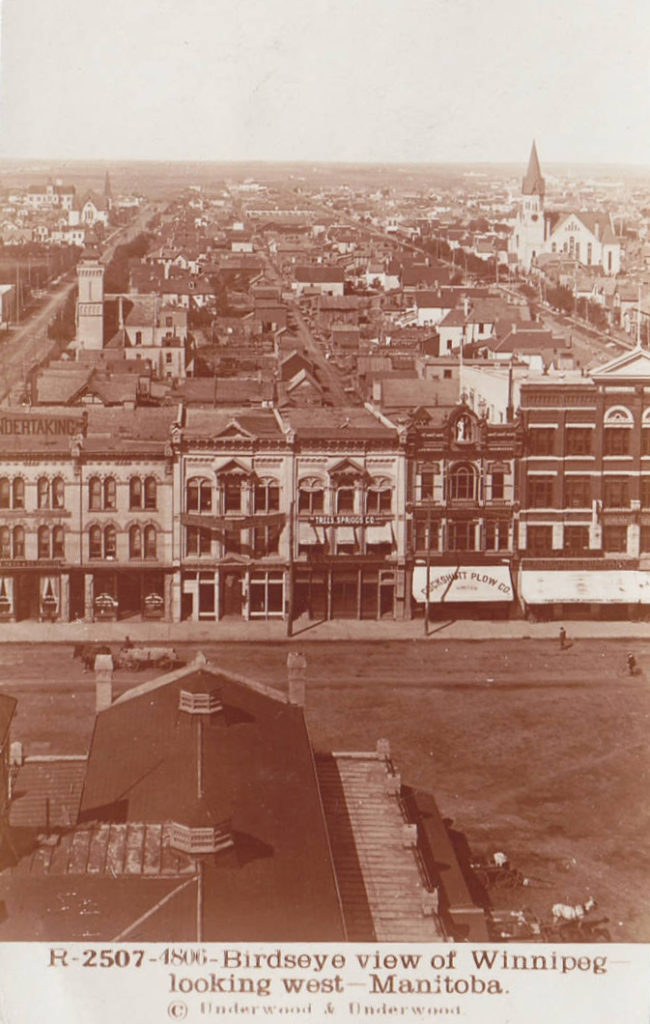
Today Red River College’s Princess Campus, these buildings were all originally commercial ventures opposite Market Square.
Source: Robert McInnes Postcard Collection
Butchers and grocers quickly filled up the available space in the Market Building. There was room for some 24 vendors inside, and others set up stalls outside the building when the weather was agreeable. Wholesalers arrived as early as six in the morning to vie for one of the outdoor spots. Renting one of these stalls went for the price of ten cents per day. A Telegram report from 1899 described the hustle and bustle of the market at Christmas. Vendors such as Kobold and Company, J.B. Lauzon, Rocan & Company, and Gallagher and Sons had stocked their displays with festive meats and treats, while banners and garlands hung from the buildings high ceilings. It was commonplace for butchers to compete for the most stunning Christmas displays. Hank Scott, a former Winnipeg alderman, recalled seeing turkeys hung as if they were in mid-flight, sides of beef decorated with paper flowers, and frozen fish stacked like “cordwood on sleighs”.
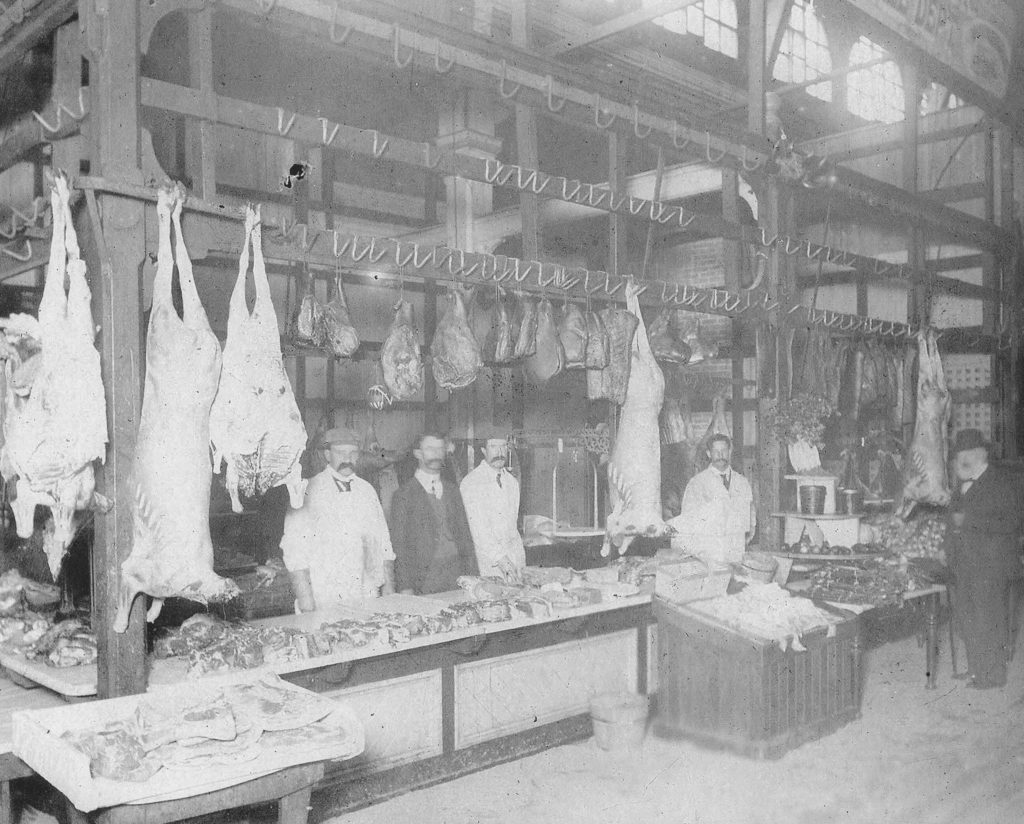
A butcher’s stall inside the City Market in 1884.
Source: City of Winnipeg Archives
The spacious grounds outside of the Market Building lent well to additional market stalls and public gatherings of all kinds. Political candidates took to soapboxing outside of the Market Building, including future strike leader George Armstrong; others held larger rallies, with speakers, either to campaign for or against city council decisions.
Larger military demonstrations also took place in Market Square over the duration of the First World War, and several parades and protests used Market Square as their starting point. Images from the time show Market Square congested with people walking nearly shoulder to shoulder. In July of 1919, to celebrate Peace Day, a large community dance was held in Market Square. Instead of a stage, the band was placed on the roof of the Market Building. As a makeshift civic arena, the Market Square made perfect sense. There was a large amount of space, the chance to attract passersby who were browsing the market, and, of course, City Hall was right next door.
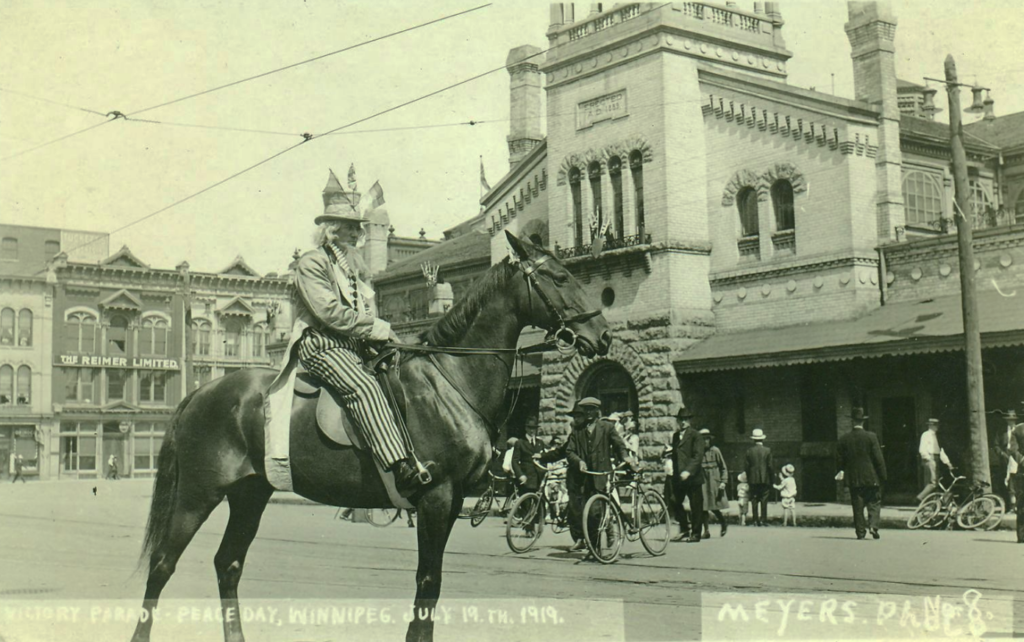
A man in a costume celebrates outside of the Market Building as part of the Peace Day Celebrations on July 19th, 1919.
Source: Robert McInnes Postcard Collection
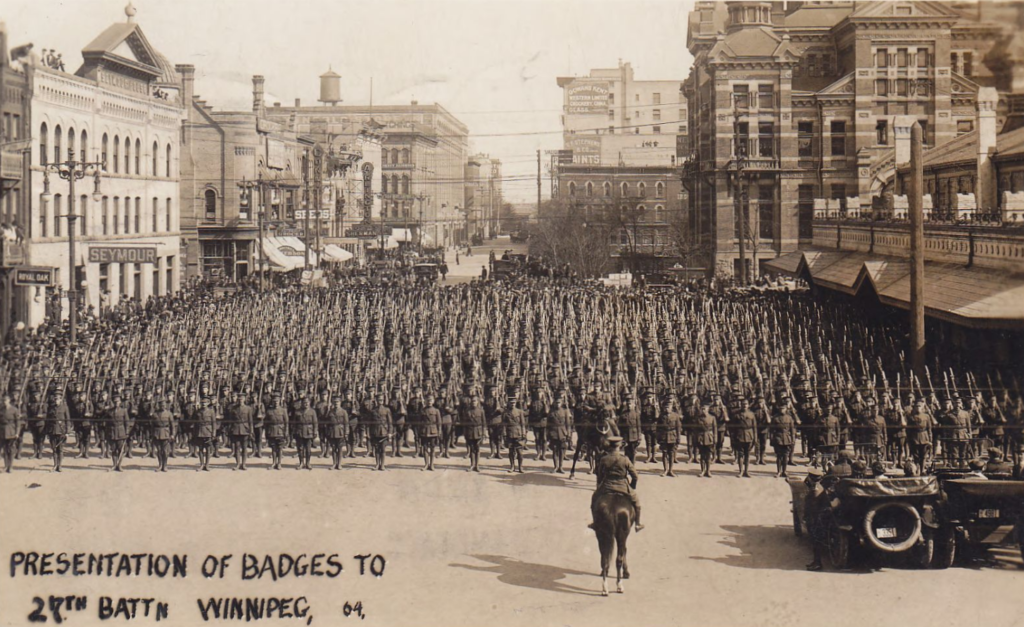
Presentation of Badges to 27th Battalion in 1915 with the Market Building just to the right.
Source: Robert McInnes Postcard Collection
The Old Market Building closed in 1919, as the city growth expanded residential neighbourhoods further and further away from the city core. An influx of corner stores, delivery trucks, and ease of access to shops meant a public market was less of a necessity. At this point, a city market official estimated that between 75 to 100 loads of vegetables were brought to the market each morning by gardeners and wholesalers. Demolition began in mid-1919 to build a new Civic Office under the supervision of city architect R.L. Davies. The onset of the Winnipeg General Strike in May of 1919 delayed construction, and several pro and anti-strike meetings were held on the Market Building grounds. By 1920, the former Market Building had been renovated into a new three-story civic office.
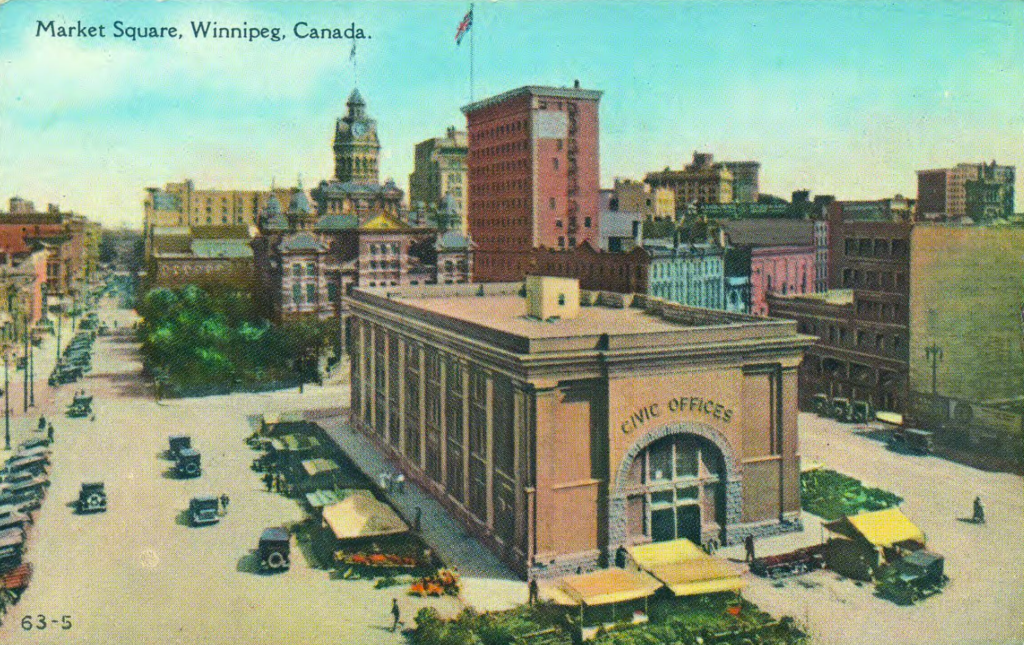
Winnipeg Civic Offices. Notice that the entrances are the same as the old Market Building.
Source: Winnipeg Postcard Collection
The footprint of the building was more or less the same, and people continued to utilize the extra space outside both as a market and meeting place. A little over a decade after the building’s renovation, Market Square saw its most violent confrontation yet: the Battle at Market Square.
At the time it was framed as a clash between fascists and communists in Winnipeg when in reality, it was a rally to oppose the growth of a Canadian Nationalist Party, led by William Whittaker. Formed in 1933, the Nationalists heavily borrowed Nazi-party rhetoric and peddled anti-Semitic newspapers on Winnipeg street corners. Steps were taken to block the publication of the Nationalist newspaper, but Whittaker and his following continued to hold public rallies – until the June of 1935. Whittaker had organized a Nationalist rally in Market Square at 8:00 pm on June 5th, however, unbeknownst to him, a large number of counter-protesters were planning on arriving early to the party.
Roughly one hundred of Whittaker’s men arrived at Market Square, dressed in brown shirts startlingly reminiscent of Nazi uniforms, and were met with nearly 500 counter-protests – among them, members of the Winnipeg Communist Party, the Jewish Anti-Fascist League, and others. A brawl broke out as knives flashed in the waning sunlight and boards were stripped from market stalls and used as makeshift clubs. By the time police arrived on the scene to break up the riot, over 20 were injured and 9 were arrested. This was not the end of the Canadian Nationalist Party, though it deterred them from hosting further public meetings. In 1999, well after the Civic Offices had been demolished, activists in Winnipeg organized a series of rallies and speeches in Old Market Square to commemorate the 1935 riot.
The 1950s and 60s marked an era of immense urban renewal in downtown Winnipeg, with the construction of a new City Hall (510 Main Street), the Manitoba Museum (190 Rupert Avenue) and Centennial Concert Hall (555 Main Street) and, of course, the Public Safety Building (151 Princess Street). In the eyes of some civic officials and planners, it was time to do away with the old and embrace the new; buildings dating back to the 1880s and 90s were demolished to make way for new and exciting construction projects, Winnipeg’s old Market Building among them. The Market Building was demolished in 1964 and quickly replaced by the Public Safety Building in 1966. Winnipeg’s outdoor market moved half a block south, to Old Market Square, and a new era was on the horizon for the city’s downtown.
However, The vision for a new and revitalized downtown was never fully realized, and the Public Safety Building was unfortunately demolished in 2020. Market Square finds itself standing at the precipice of a new era once again, ready to be reinvented and find new life and purpose in the downtown identity. That is, with some specific criteria in mind. The deed for the former Public Safety Building property is clear on the desires set by the Ross family for the intended land use, and states that the property should be used for a “suitable Market House” and should the Corporation of the City of Winnipeg “…use the said lands and premises for any other purposes or uses than those directly connected with the public purposes and uses of the Corporation then the said lands and premises and every part hereof shall immediately revert to and agrees become the property of the … heirs and assigns…”.
What this means, in essence, is that whatever may be in store for the future of this site it will be for the good of the neighbourhood it resides in and will hopefully keep its role in the formation of the community’s future identity in mind. Whether through a built space, a parkscape, or a combination of both, Heritage Winnipeg hopes that the next iteration of Winnipeg’s Market will respect its history while striving towards creating an inclusive and sustainable downtown, for Winnipeggers to benefit from for another century and beyond.
THANK YOU TO THE SPONSOR OF THIS BLOG POST:

Written by Heritage Winnipeg.
SOURCES:
Winnipeg Tribune Files
Winnipeg Free Press Files
Planning with Purpose – Fire Hall No. 1
Designated Heritage: Saving the Past for the Future!
CentreVenture, Market Lands Project
Old Market Square, Winnipeg Downtown Places
The Massey Building: Prairie Prosperity
The Masonic Temple: From Secrets to Success
Borrowed Buildings: Treating The 1918 Influenza Epidemic
Winnipeg Free Press, Sep 6, 1876 (3)
"Farewell Market Square and History", The Winnipeg Evening Tribune, 1964-09-12 (Page 6)












